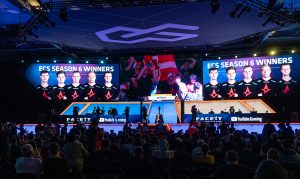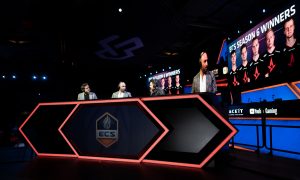Inside Esports Stadium Arlington, North America’s Largest — and Most Flexible — Esports Venue
The 100,000-sq.-ft. facility is part of an initiative to build a local esports community
Story Highlights
When Esports Stadium Arlington officially opened in November, the $10 million, 100,000-sq.-ft. facility represented the most significant commitment to esports by a municipality to date. Located in the Arlington, TX, Entertainment District, not only is it the largest dedicated esports facility in North America, but it’s also an extremely versatile venue, having already hosted events ranging from FACEIT’s Esports Championship Series (ECS) Finals to the Collegiate Rocket League National Championship.
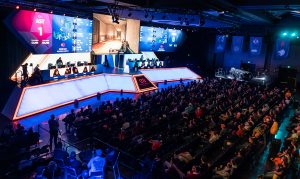
The $10 million, 100,000-sq.-ft. Esports Stadium Arlington is the largest esports-focused venue in North America to date.
“This is the most flexible and adaptable esports stadium in the world,” says Corey Dunn, executive producer, NGAGE Esports, which manages all events at the venue. “One of our main goals was to create a space that could bring in many different types of users. The [show] we produce one weekend is probably going to be very different from what we’re doing the next weekend. So, from a production standpoint, the biggest difference with what we’re doing in our facility compared with other esports or [traditional sports] venues is, we have to take different approaches for almost every event we do.”
Experiential Venue: More Than Just a Spot To Watch the Game
However, ES Arlington — which is a joint venture of the city of Arlington and Esports Venues LLC (an arm of Infinite Esports, which is owned by Texas Rangers co-owner/COO Neil Leibman) and was designed by Populous — is much more than an arena to host live esports competitions. Besides a state-of-the-art competition space, it features a Gaming Center with 50-plus gaming stations open to the public seven days a week, as well as retail and social spaces (including food and beverage), premium hospitality offerings, broadcast and production studios, and ultramodern team training facilities.
“The reality is that these [esports] fans want to be together for a cultural and social experience, and we’re creating the environment to make that possible,” says Brian Mirakian, senior principal/director for Activate, Populous. “However, they’re not there to sit in their seat the entire time; they’re there to choose an experiential adventure.
“That’s where the gaming center comes into play,” he continues. “You could be at a tournament for eight to 10 hours, but you have the ability to walk out and socialize with your friends and participate in games. There is the ability for you to be able to migrate from place to place, and, ultimately, that’s the driving factor behind this project.”
The project to transform an underutilized space at the Arlington Convention Center into an esports-specific venue was completed in just six months. Populous enlisted Shawmut as its construction partner and systems integrator SimplyNew to build out the technology for the venue’s media and IT architecture, broadcast studio, and A/V.
“I think that the number-one thing that’s important for people to realize about this facility is that it’s a fully immersive experience — not just a place where you watch a game and leave, which is what most sporting events are,” says SimplyNew co-founder Marc Scarpa. “This is a fully immersive experiential entertainment center, and it starts the moment you walk in the door of the building.”
Inside the Arena: A Fully Immersive Competition Space
The competition arena itself boasts an 85-ft-long LED board and features an immersive, 5.1 surround sound system built on a Dante IP audio network and a dynamic theatrical lighting system.
To serve the wide variety of competitions expected to be held in Arlington, the main stage can accommodate events ranging from 1 v 1 to 7 v 7 and up to 100 game stations for battle royale competitions. The venue can also host conferences and corporate events outside of esports. Seating can be scaled from 250 to 2,500 spectators.
Dunn, a veteran of the esports scene for more than a decade and one of the industry’s most experienced producers/directors of live esports events, is overseeing all production at the facility and sees its flexibility as key to its success.
“One of the key things that we have to be cognizant of is knowing how to integrate our local resources into [customers’] ecosystem because every [show] is different,” he explains. “You’ve got people that are extremely technical and highly proficient in [esports] production, and then you have others that are still learning. You’ve got people that need a lot of our resources and others that have every resource and just want to be able to come into the space and load in. We’ve got to be able to serve both equally well.”
Eight Grass Valley LDX 86N 4K-capable cameras are on hand for in-arena coverage: two handhelds, three long-lens cameras, a jib, and two studio cameras. The long-lens cameras are outfitted with the new Canon UHD-DIGISUPER UJ 66X9B box zoom lenses, the camera manufacturer’s first 4K-compatible medium telephoto broadcast lens. Focal length on the telephoto end was a priority for ES Arlington, and it was the first facility in the world to receive the new Canon lenses, which offer 66X magnification and the operability of a 2/3-in. HD field lens along with telephoto-end focal length of 600mm (1,200mm when using the built-in 2X extender).
On stage, up to a dozen Blackmagic Design player cameras can be deployed and subswitched separately via a Blackmagic ATEM switcher. Three additional Blackmagic POVs provide wide shots and beauty shots of the entire area. Three Sony PTZ cameras are also on hand: one for the caster studio, two for down-the-line shots on stage.
Control Room, Observer Room Offer Plenty of Tech Firepower
The entire production facility is 1080p60 (an absolute must in esports) and is 4K-ready should the venue opt to upgrade in the future. The main control room features three benches, which can be leveraged at different scales, and produces the live feed for both the streaming and in-venue experiences. The observer room produces the in-game action (“observers” are essentially the in-game camera operators) while the main control room handles the overall show.
“There was no question going in that we were doing a 1080p facility. That was a given from the beginning,” says Scarpa. “And we went in with a 4K-ready solution so that they can do upgrades down the line as opposed to having to rebuild the whole facility. There’s also fiber throughout the facility, so the infrastructure and the skeleton are there already when they decide to do that upgrade.”
At the heart of the production operation is a 4M/E Grass Valley Karrera K-Frame S-Series switcher (64 inputs/32 outputs), as well as Grass Valley Densité and enterprise-class NVISION 8280 routing systems.
The main stage LED, player pod displays, and the pre-event lobby LED display are driven with Ross Video products, including a Carbonite Mosaic video processor, XPression Tessera real-time 3D graphics render engine, and DashBoard control system.
Other equipment includes a Grass Valley LiveTouch replay network (15 input, four output), Riedel intercom system, and a Vizrt three-channel CG system for graphics. The 5.1-surround audio-mixing room features a Yamaha console and Genelec speakers.
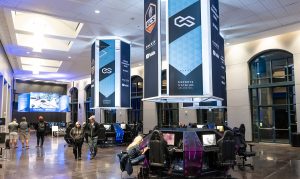
Esports Stadium Arlington features a Gaming Center with 50-plus stations open to the public seven days a week.
Other key production areas include the caster studio, where shoutcasters call the action from a studio desk with a chroma key greenscreen background, and a postproduction area.
The equipment room houses 19 racks of gear, and more than 200,000 ft. of fiber and copper cabling has been laid throughout the facility. ES Arlington also has full encoding capability to all streaming broadcast platforms and is fully compatible with a mobile unit should the client require it.
Beyond the Arena: Gaming Center, Team Area Help Build Esports Community
The Gaming Center is as integral to the facility as the arena itself, as the local industry seeks to build a robust esports community in Arlington. Gamers from throughout the Dallas/Fort Worth area can come in seven days a week (12 p.m. – 2 a.m.) to play all the latest games on more than 50 gaming stations — NVIDIA-powered PCs with 240-Hz G-Sync monitors or PlayStation 4, Nintendo Switch, and Xbox One consoles — while engaging with other local gamers (with full access to food and beverage and the ES Arlington retail store).
In addition to daily pay-to-play gaming, ES Arlington hosts weekly and monthly meet-ups, tournaments, and other events inside a mini arena in the Gaming Center to further enrich the community experience.
Also contributing to that goal, the Team Area focuses on training and provides players with a communal space comprising eight “Team Rooms,” space for players to strategize and practice; a “Player Lounge,” where players can relax and socialize; and media and staff areas.
“This is about much more than just the main competition venue,” says Mirakian. “There were four primary goals that programmatically we wanted to achieve with the building: the Gaming Center, the competition venue, the production studio, and the team training facilities. We believe all four are absolutely critical to success.”
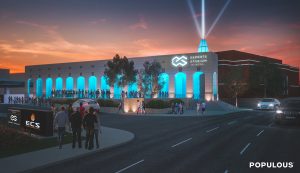
The ES Arlington project (shown in a rendering) transformed an underutilized space at the Arlington Convention Center into an esports-specific venue in just six months.
The stadium opened with a bang. Its first event, FACEIT’s ECS Season 6 Finals, became the most-watched CS:GO live stream ever on YouTube, peaking with concurrent viewership of 233,950 on the English-language broadcast and logging 3.2 million hours of total watch time (2.4 million of those during the Finals). In December, Arlington hosted Collegiate Rocket League National Championship and Ultimatum, a two-day Smash Bros Ultimate event.
With plenty more events to be announced in 2019, Dunn and company foresee a thriving esports community in Arlington.
“Our No. 1 goal right now is building a community, which then builds up our audience base. And I think we’re already seeing that happen,” Dunn says. “What’s really been exciting has been the impressions from our audiences. One of the coolest things I saw on social media was, a father and son came to the venue together and both loved it. Seeing how we are making an impression on gamers and non-gamers has been really great.”
